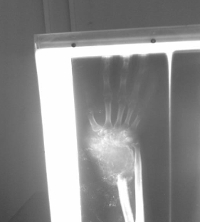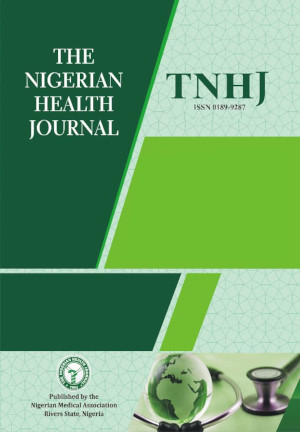Vascularised Fibular Graft for a Radial Defect following Tumour Excision in a Tertiary Institution in Nigeria
Keywords:
Bone graft, Bone defects, Vascularised Graft, Fibular.Abstract
Background: Options for bridging large segmental bone defects following trauma or surgical resection are numerous. Various methods have been described and tried out, each having its advantages and drawbacks. In developing countries, the choices are limited due to unavailability and high cost of sophisticated implants and materials, and the relative lack of expertise to carry out some of these procedures.
Objective: This case report highlights the use of a free vascularised fibular graft to bridge a large radial bony defect following tumour resection at a tertiary hospital in Nigeria.
Case report: Mr J. A, a 30 year old businessman, had an excision biopsy of a mass originating from his distal right radius. The histopathology report confirmed it to be a giant cell tumour. He was however left with a large (approximately 10cm) radial defect, which was subsequently bridged with a vascularised fibular graft. Post operatively, his hand and wrist functions were satisfactory.
Conclusion: Free vascularised fibular graft is a viable option for bridging large bone defects in developing countries. As long as the expertise is available, it is less complicated and more economical than other advanced methods. It has fewer drawbacks when compared with the methods currently in use in our environment.
References
Getty PJ, Peabody TD. Complications and functional outcomes of reconstruction with an osteoarticular allograft after intra-articular resection of the proximal part of the humerus. J Bone Joint Surg Am 1999;81A:1138–1146
Yuan Sun, Changqing Zhang, DongxuJin, Jiagen Sheng, Xiangguo Cheng, Xudong Liu, Shengbao Chen, and Bingfang Zeng,Free vascularised fibular grafting in the treatment of large skeletal defects due to osteomyelitis international orthopaedics, March 2010, Volume 34, Issue 3, pp 425-430
Gebert C, Hillmann A, Schwappach A, et al. Free vascularised fibular grafting for reconstruction after tumour resection in the upper extremity.J SurgOncol 2006;94:114-127
Alexander B. Dagum, MD, FRCS(C)Skeletal Reconstruction of the Upper Extremity With a Vascularised Fibula Graft: Clinical Applications, Techniques, and Results.Plastic Surgery Pulse News2011: Vol 2 Number 4
Innocenti M, Delcroix L, Manfrini M, et al. Vascularised proximal fibular epiphyseal transfer for distal radial reconstruction. J Bone Joint Surg Am 2004;86A:1504–1511.
Y. Z. Lawal, E. S. Garba1, M. O. Ogirima, I. L. Dahiru, M. I. Maitama, K. Abubakar2, F. S. Ejagwulu; Use of non-vascularized autologous fibula strut graft in the treatment of segmental bone loss, Annals of African Medicine Vol. 10, No. 1; 2011:25-8
B. Omololu, S. O. Ogunlade, T. O. Alonge; Limb conservation using non vascularised fibular grafts, West African Journal of Medicine, october-december 2002; 21:347-349
OC Nwokike, JE Onuminya, E Esezobor, E Edomwonyi, DO Olomu; Management of Bone Gaps with Intramedullary Autologous Fibular Strut Graft, Nigerian Journal of Orthopaedics and Trauma(2013), Vol 12; No 1
Collin T, Sugden P, Ahmed O, et al. Technical considerations of fibular osteocutaneous flap dissection. J PlastReconstrAesthetSurg 2008; 61:1503-1506.

Downloads
Published
How to Cite
Issue
Section
License
Copyright (c) 2016 The Nigerian Health Journal

This work is licensed under a Creative Commons Attribution-NonCommercial-NoDerivatives 4.0 International License.
The Journal is owned, published and copyrighted by the Nigerian Medical Association, River state Branch. The copyright of papers published are vested in the journal and the publisher. In line with our open access policy and the Creative Commons Attribution License policy authors are allowed to share their work with an acknowledgement of the work's authorship and initial publication in this journal.
This is an open access journal which means that all content is freely available without charge to the user or his/her institution. Users are allowed to read, download, copy, distribute, print, search, or link to the full texts of the articles in this journal without asking prior permission from the publisher or the author.
The use of general descriptive names, trade names, trademarks, and so forth in this publication, even if not specifically identified, does not imply that these names are not protected by the relevant laws and regulations. While the advice and information in this journal are believed to be true and accurate on the date of its going to press, neither the authors, the editors, nor the publisher can accept any legal responsibility for any errors or omissions that may be made. The publisher makes no warranty, express or implied, with respect to the material contained herein.
TNHJ also supports open access archiving of articles published in the journal after three months of publication. Authors are permitted and encouraged to post their work online (e.g, in institutional repositories or on their website) within the stated period, as it can lead to productive exchanges, as well as earlier and greater citation of published work (See The Effect of Open Access). All requests for permission for open access archiving outside this period should be sent to the editor via email to editor@tnhjph.com.



